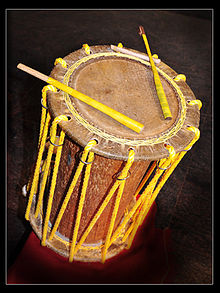- Chande
-
- for the village in Nepal see Chande, Nepal
The chande is a drum used in the traditional and classical music of South India and particularly in Karnataka. It provides rhythmic accompaniment in several dance dramas of South India such as Yakshagana. It follows the Yakshagana Tala system. The rhythms are based on pre-classical music forms, folk groves and some rhythms are similar to Karnataka Sangeta and to lesser extent Hindustani Sangeetha.[1] There are different varieties in this instrument. Two major varieties are the Badagu Thittu Chande (Northern School) and the Thenku Thittu Chande (Southern School). The later is also spelt as chenda and is used exclusively in the art forms of southern costal Karnataka and Kerala. This article deals with Badagu Thittu Chande used exclusively in Yakshagana of Karnataka. The chande used in Badagu Thittu is structurally and acoustically different from chenda used in Kerala.
Contents
History
In ancient Hindu sculpture, painting, and mythology, the chande is often depicted as the instrument used to declare war (Rana Chande - war drum). This instrument can produce complicated rhythms that can be heard from more than 3 km.
Its body is constructed from wood of the jackfruit (or Kakke/Baine/Jambe) tree. It follows the Yakshagana system of talas (or taalams) that resemble South Indian Karnataka Sangeta talas but also includes folk and traditional compositions. The rhythm system itself has pre-classical origins.
Physical components
The circular drum head is made of processed cow skin. Usually there are 12 hinges that hold the drum head to the wooden trunk using thick ropes. Wedges inserted inside the ropes are twisted to tighten or loosen the drum head while tuning. A tubular wooden wedge sits at one edge of the durm head to be used by the stick of dominant hand. Traditionally the chande must be tuned to the tonic of the singer.
Posture
The chande is played resting it vertically on the floor using two sticks.
Chande sticks
Chande sticks are drum sticks called Chande Kolu in Kannada. These are specially made for chande. The shape and thickness varies along the stick.
Methods of use
The sticks are flexible and are usually made from a type of Bamboo. The head of the stick used for the dominant hand is thicker and the body tapers and the end where the hand grips the stick is of normal size. The other stick is slightly thicker and less tapered. The dominant stick usually rests on the wedge of the drum head and the stick is rolled to produce the fluttering sound. It is this feature that gives chande an advantage of producing multiple fillers in between the beats that hands or fingers usually will not be able to produce on drums. It is played in a forceful manner. The chande groves form what is called the Yakshagana Tala.
Audio Sample
Yakshaganic drum rudiments
The students of Chande have to learn some rudiments to be able to master playing Chande. These include the following.
Stick Combination
Various (left)L (right)R combination.
Rolling
Learning "Horalike" (literally rolling) involves learning:
- Ka da thka
- Ta ka da
and their combination. For advanced performances players learn double (Eradhoralke) and triple rolling (Moorhorlke).
See also
- Karatalas
- Maddale
- Tabla
- Tala-Maddale
- Thavil
References
- ^ Prof. Sridhara Uppura, Yakshagana and Nataka, Diganta Sahitya Publications, 1998, Managalore.
External links
- Chande video (the chande is to the singers' right, and a Maddale is being played on the platform behind the singers)
- A Chade Tala demonstration by artist Chande Mahabhaleshwara Mudugodu on YouTube
- A Chande rhythm demonstration - Keshav Bhandari Karki on YouTube
Categories:- Carnatic music instruments
- Percussion instruments
- Pitched percussion
- Indian musical instruments
- Yakshagana
Wikimedia Foundation. 2010.


